the great wall教案
- 格式:doc
- 大小:27.50 KB
- 文档页数:5
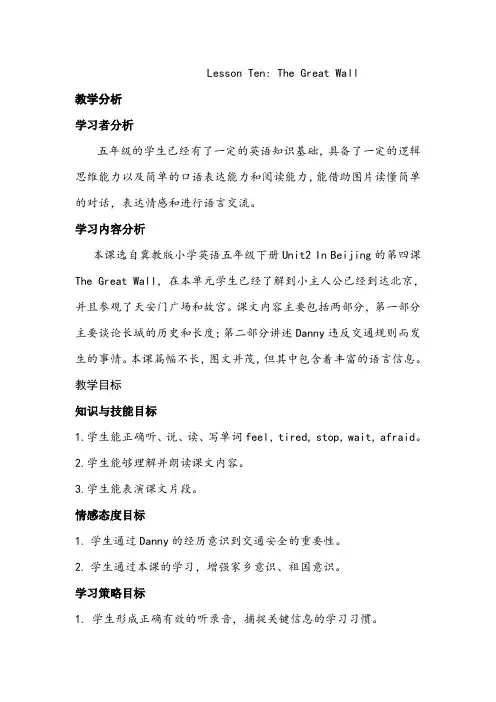
Lesson Ten: The Great Wall教学分析学习者分析五年级的学生已经有了一定的英语知识基础,具备了一定的逻辑思维能力以及简单的口语表达能力和阅读能力,能借助图片读懂简单的对话,表达情感和进行语言交流。
学习内容分析本课选自冀教版小学英语五年级下册Unit2 In Beijing的第四课The Great Wall,在本单元学生已经了解到小主人公已经到达北京,并且参观了天安门广场和故宫。
课文内容主要包括两部分,第一部分主要谈论长城的历史和长度;第二部分讲述Danny违反交通规则而发生的事情。
本课篇幅不长,图文并茂,但其中包含着丰富的语言信息。
教学目标知识与技能目标1.学生能正确听、说、读、写单词feel,tired, stop, wait, afraid。
2.学生能够理解并朗读课文内容。
3.学生能表演课文片段。
情感态度目标1.学生通过Danny的经历意识到交通安全的重要性。
2.学生通过本课的学习,增强家乡意识、祖国意识。
学习策略目标1.学生形成正确有效的听录音,捕捉关键信息的学习习惯。
2.学生能增强自身的寻读、默读、朗读等语篇阅读策略。
3. 学生形成正确有效的听录音和模仿跟读的学习习惯。
4.学生在活动中积极与同学合作,共同完成任务。
教学重难点教学重点1.学生能正确听、说、读、写单词feel,tired, stop, wait, afraid。
2.学生能够理解并朗读课文内容。
教学难点学生表演课文片段。
教学过程Step1 Warm-up1.Let’s Sing教师播放本单元歌曲“Let’s take a picture, you and me .”学生根据节奏跟唱。
设计意图:用歌曲引入英语课堂,使学生进入英语学习环境。
2.At the hotel2.1教师出示图片,问问题,学生回答。
T:Where are Jenny,Danny, and Li Ming?S: They are …….设计意图:学生充分理解李明的说话地点,为后面的旅游长城打基础。
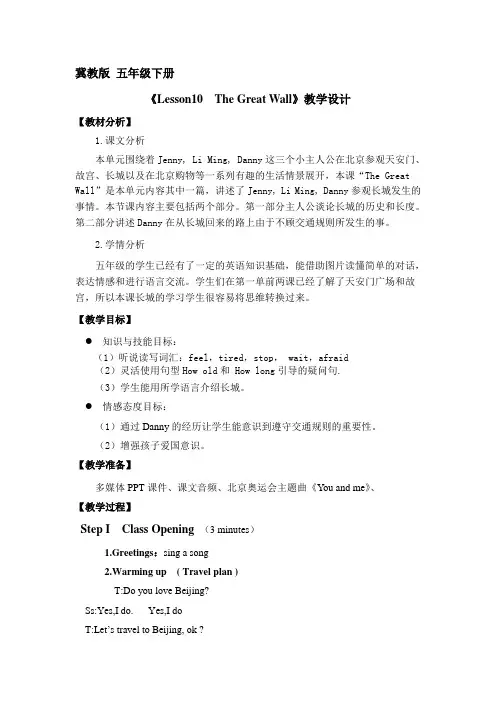
冀教版五年级下册《Lesson10 The Great Wall》教学设计【教材分析】1.课文分析本单元围绕着Jenny, Li Ming, Danny这三个小主人公在北京参观天安门、故宫、长城以及在北京购物等一系列有趣的生活情景展开,本课“The Great Wall”是本单元内容其中一篇,讲述了Jenny, Li Ming, Danny参观长城发生的事情。
本节课内容主要包括两个部分。
第一部分主人公谈论长城的历史和长度。
第二部分讲述Danny在从长城回来的路上由于不顾交通规则所发生的事。
2.学情分析五年级的学生已经有了一定的英语知识基础,能借助图片读懂简单的对话,表达情感和进行语言交流。
学生们在第一单前两课已经了解了天安门广场和故宫,所以本课长城的学习学生很容易将思维转换过来。
【教学目标】●知识与技能目标:(1)听说读写词汇:feel,tired,stop, wait,afraid(2)灵活使用句型How old和 How long引导的疑问句.(3)学生能用所学语言介绍长城。
●情感态度目标:(1)通过Danny的经历让学生能意识到遵守交通规则的重要性。
(2)增强孩子爱国意识。
【教学准备】多媒体PPT课件、课文音频、北京奥运会主题曲《You and me》、【教学过程】Step I Class Opening (3 minutes)1.Greetings:sing a song2.Warming up ( Travel plan )T:Do you love Beijing?Ss:Yes,I do. Yes,I doT:Let’s travel to Beijing, ok ?Ss: okT:Did you go to the Palace Museum?Ss:Yes,I did Yes,I didT:Did you go to Tan’anmen Square?Ss:Yes,I did Yes,I didT:Did you go to the Great Wall?Ss:No,I didn’t. No,I didn’tT: Today let’s go to the Great Wall. (板书课题)设计目的:(简单的说唱形式营造轻松的英语课堂氛围,导入新课。
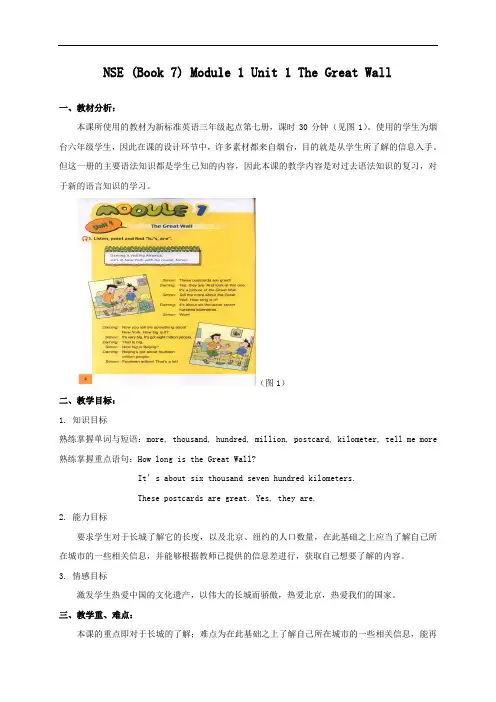
NSE (Book 7) Module 1 Unit 1 The Great Wall一、教材分析:本课所使用的教材为新标准英语三年级起点第七册,课时30分钟(见图1)。
使用的学生为烟台六年级学生,因此在课的设计环节中,许多素材都来自烟台,目的就是从学生所了解的信息入手。
但这一册的主要语法知识都是学生已知的内容,因此本课的教学内容是对过去语法知识的复习,对于新的语言知识的学习。
(图1)二、教学目标:1. 知识目标熟练掌握单词与短语:more, thousand, hundred, million, postcard, kilometer, tell me more 熟练掌握重点语句:How long is the Great Wall?It’s about six thousand seven hundred kilometers.These postcards are great. Yes, they are.2. 能力目标要求学生对于长城了解它的长度,以及北京、纽约的人口数量,在此基础之上应当了解自己所在城市的一些相关信息,并能够根据教师已提供的信息差进行,获取自己想要了解的内容。
3. 情感目标激发学生热爱中国的文化遗产,以伟大的长城而骄傲,热爱北京,热爱我们的国家。
三、教学重、难点:本课的重点即对于长城的了解;难点为在此基础之上了解自己所在城市的一些相关信息,能再学习的本课重点句型之后,进行提问以获取自己想要了解的信息。
四、教具学具:课本,单词卡片,明信片,课件,教学配套光盘。
五、教学过程:Step 1 Warming upFree talk between the teacher and the students. Make the students ask teacher some questions according to the words and pictures on the screen. (见图2)And it’s also a competition.(在整节课中,只要学生回答对问题,老师会奖励这组学生一张拼图。
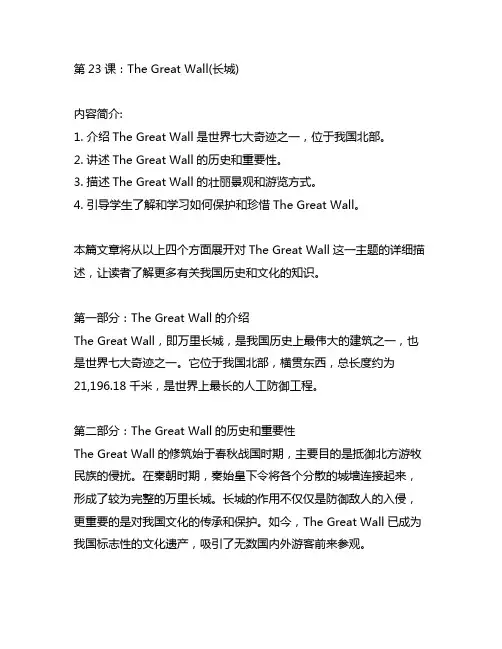
第23课:The Great Wall(长城)内容简介:1. 介绍The Great Wall是世界七大奇迹之一,位于我国北部。
2. 讲述The Great Wall的历史和重要性。
3. 描述The Great Wall的壮丽景观和游览方式。
4. 引导学生了解和学习如何保护和珍惜The Great Wall。
本篇文章将从以上四个方面展开对The Great Wall这一主题的详细描述,让读者了解更多有关我国历史和文化的知识。
第一部分:The Great Wall的介绍The Great Wall,即万里长城,是我国历史上最伟大的建筑之一,也是世界七大奇迹之一。
它位于我国北部,横贯东西,总长度约为21,196.18千米,是世界上最长的人工防御工程。
第二部分:The Great Wall的历史和重要性The Great Wall的修筑始于春秋战国时期,主要目的是抵御北方游牧民族的侵扰。
在秦朝时期,秦始皇下令将各个分散的城墙连接起来,形成了较为完整的万里长城。
长城的作用不仅仅是防御敌人的入侵,更重要的是对我国文化的传承和保护。
如今,The Great Wall已成为我国标志性的文化遗产,吸引了无数国内外游客前来参观。
第三部分:The Great Wall的壮丽景观和游览方式The Great Wall的壮丽景观令人叹为观止。
长城的建筑风格各异,有的雄伟险峻,有的柔美如玉。
其中著名的八达岭长城、司马台长城、金山岭长城等景点都是游客们向往的旅游胜地。
游客们可以徒步登上长城,感受其宏伟壮丽;也可以乘坐缆车或索道,俯瞰长城的全貌。
另外,长城上还有丰富多彩的文化活动和表演,使游客们对我国古代文化有更深入的了解。
第四部分:保护和珍惜The Great WallThe Great Wall虽然历经千年,但依然面临着许多挑战,如天气侵蚀、人为破坏等。
保护和珍惜The Great Wall已成为全社会的共同责任。
政府和社会组织不断加大对长城的保护力度,修缮破损部分,严格管理游客的行为。
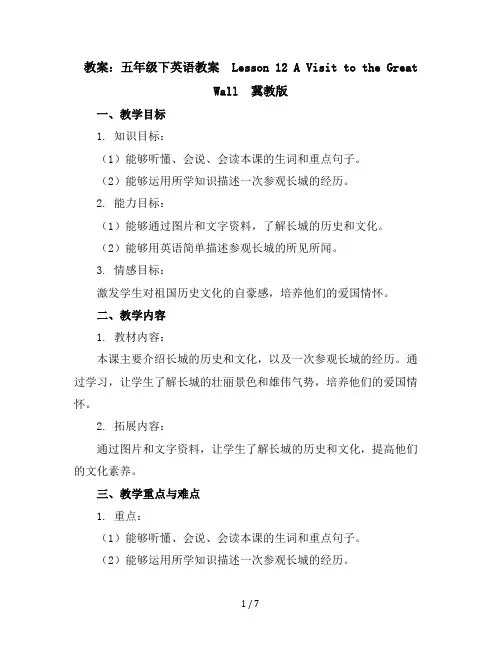
教案:五年级下英语教案 Lesson 12 A Visit to the GreatWall 冀教版一、教学目标1. 知识目标:(1)能够听懂、会说、会读本课的生词和重点句子。
(2)能够运用所学知识描述一次参观长城的经历。
2. 能力目标:(1)能够通过图片和文字资料,了解长城的历史和文化。
(2)能够用英语简单描述参观长城的所见所闻。
3. 情感目标:激发学生对祖国历史文化的自豪感,培养他们的爱国情怀。
二、教学内容1. 教材内容:本课主要介绍长城的历史和文化,以及一次参观长城的经历。
通过学习,让学生了解长城的壮丽景色和雄伟气势,培养他们的爱国情怀。
2. 拓展内容:通过图片和文字资料,让学生了解长城的历史和文化,提高他们的文化素养。
三、教学重点与难点1. 重点:(1)能够听懂、会说、会读本课的生词和重点句子。
(2)能够运用所学知识描述一次参观长城的经历。
2. 难点:(1)生词和短语的理解和运用。
(2)描述参观长城的经历。
四、教具与学具准备1. 教具:(1)课件:包括本课的生词和重点句子,以及与长城相关的图片和文字资料。
(2)黑板和粉笔。
2. 学具:(1)课本。
(2)练习本。
五、教学过程1. 导入:通过课件展示长城的图片,引导学生谈论长城的美丽景色,激发他们的学习兴趣。
2. 新课呈现:(1)教师引导学生学习本课的生词和短语,并通过例句展示它们的用法。
(2)教师播放课文录音,让学生跟读并模仿语音语调。
3. 课堂练习:(1)学生分组进行角色扮演,模拟一次参观长城的经历。
(2)学生用英语描述自己所见所闻,并尽量使用本课所学词汇和句型。
4. 拓展活动:学生通过查找资料,了解长城的历史和文化,并在课堂上进行分享。
六、板书设计板书设计如下:课题:A Visit to the Great Wall生词和短语:The Great WallancientChinesehistoryculturetouristattractionmagnificentclimbview句子:1. The Great Wall is an ancient Chinese tourist attraction.2. It has a long history and rich culture.3. We climbed the Great Wall and had a magnificent view.七、作业设计1. 抄写本课生词和短语,每个写5遍。
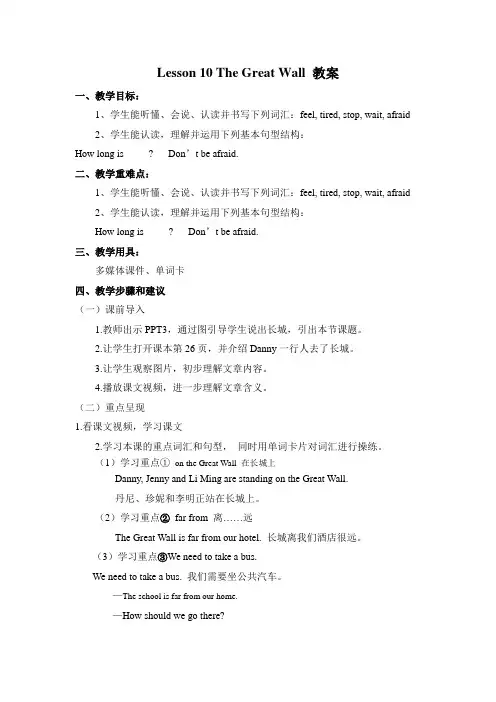
Lesson 10 The Great Wall 教案一、教学目标:1、学生能听懂、会说、认读并书写下列词汇:feel, tired, stop, wait, afraid2、学生能认读,理解并运用下列基本句型结构:How long is_____? Don’t be afraid.二、教学重难点:1、学生能听懂、会说、认读并书写下列词汇:feel, tired, stop, wait, afraid2、学生能认读,理解并运用下列基本句型结构:How long is_____? Don’t be afraid.三、教学用具:多媒体课件、单词卡四、教学步骤和建议(一)课前导入1.教师出示PPT3,通过图引导学生说出长城,引出本节课题。
2.让学生打开课本第26页,并介绍Danny一行人去了长城。
3.让学生观察图片,初步理解文章内容。
4.播放课文视频,进一步理解文章含义。
(二)重点呈现1.看课文视频,学习课文2.学习本课的重点词汇和句型,同时用单词卡片对词汇进行操练。
(1)学习重点①on the Great Wall 在长城上Danny, Jenny and Li Ming are standing on the Great Wall.丹尼、珍妮和李明正站在长城上。
(2)学习重点②far from 离……远The Great Wall is far from our hotel. 长城离我们酒店很远。
(3)学习重点③We need to take a bus.We need to take a bus. 我们需要坐公共汽车。
—The school is far from our home.—How should we go there?—We need to take the train.(4)学习重点④How long…? 用来询问长度How long is it? 它(长城)有多长?About 6000 kilometres. 大约6000公里。
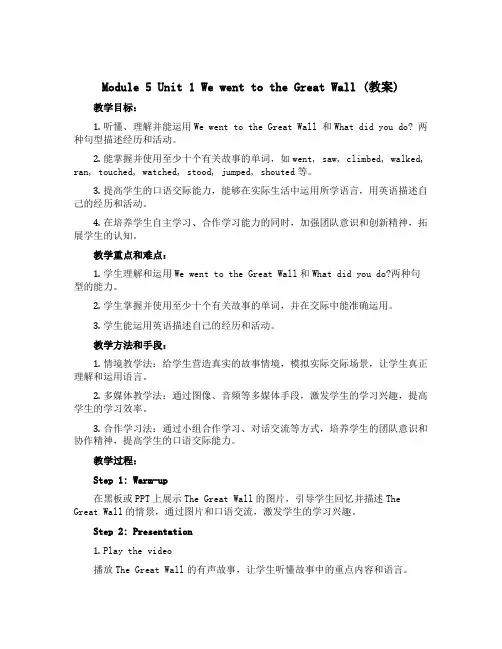
Module 5 Unit 1 We went to the Great Wall (教案)教学目标:1.听懂、理解并能运用We went to the Great Wall 和What did you do? 两种句型描述经历和活动。
2.能掌握并使用至少十个有关故事的单词,如went, saw, climbed, walked, ran, touched, watched, stood, jumped, shouted等。
3.提高学生的口语交际能力,能够在实际生活中运用所学语言,用英语描述自己的经历和活动。
4.在培养学生自主学习、合作学习能力的同时,加强团队意识和创新精神,拓展学生的认知。
教学重点和难点:1.学生理解和运用We went to the Great Wall和What did you do?两种句型的能力。
2.学生掌握并使用至少十个有关故事的单词,并在交际中能准确运用。
3.学生能运用英语描述自己的经历和活动。
教学方法和手段:1.情境教学法:给学生营造真实的故事情境,模拟实际交际场景,让学生真正理解和运用语言。
2.多媒体教学法:通过图像、音频等多媒体手段,激发学生的学习兴趣,提高学生的学习效率。
3.合作学习法:通过小组合作学习、对话交流等方式,培养学生的团队意识和协作精神,提高学生的口语交际能力。
教学过程:Step 1: Warm-up在黑板或PPT上展示The Great Wall的图片,引导学生回忆并描述The Great Wall的情景,通过图片和口语交流,激发学生的学习兴趣。
Step 2: Presentation1.Play the video播放The Great Wall的有声故事,让学生听懂故事中的重点内容和语言。
2.Vocabulary presentation通过图片、PPT等方式展示故事中的关键词汇,并逐一讲解和重复,操练每个单词的发音和拼写。
3.Sentence presentation引导学生理解We went to the Great Wall和What did you do?两种句型的意义和用法,并逐一讲解和操练句型的语音、语调和语法。
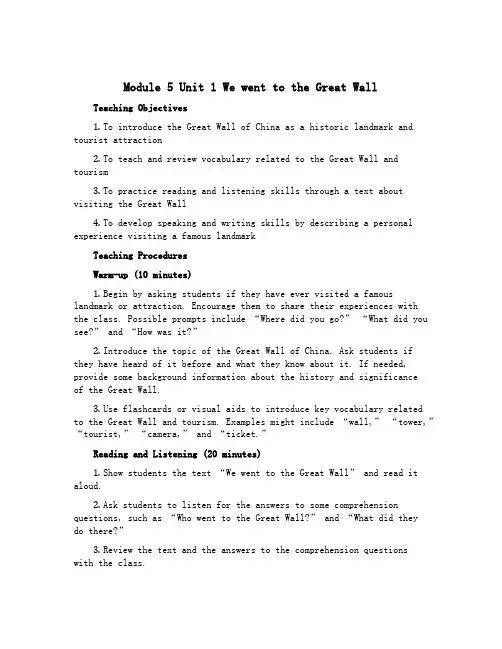
Module 5 Unit 1 We went to the Great Wall Teaching Objectives1.To introduce the Great Wall of China as a historic landmark and tourist attraction2.To teach and review vocabulary related to the Great Wall andtourism3.To practice reading and listening skills through a text aboutvisiting the Great Wall4.To develop speaking and writing skills by describing a personal experience visiting a famous landmarkTeaching ProceduresWarm-up (10 minutes)1.Begin by asking students if they have ever visited a famous landmark or attraction. Encourage them to share their experiences withthe class. Possible prompts include “Where did you go?” “What did you see?” and “How was it?”2.Introduce the topic of the Great Wall of China. Ask students ifthey have heard of it before and what they know about it. If needed, provide some background information about the history and significanceof the Great Wall.e flashcards or visual aids to introduce key vocabulary relatedto the Great Wall and tourism. Examples might include “wall,” “tower,” “tourist,” “camera,” and “ticket.”Reading and Listening (20 minutes)1.Show students the text “We went to the Great Wall” and read it aloud.2.Ask students to listen for the answers to some comprehension questions, such as “Who went to the Great Wall?” and “What did theydo there?”3.Review the text and the answers to the comprehension questionswith the class.4.Provide individual copies of the text for each student and ask them to read it silently.5.If time allows, ask students to pair up or work in small groups to retell the story in their own words.Vocabulary and Grammar (15 minutes)1.Review the key vocabulary from the text and ask students to match the words with their definitions or context sentences.2.Review the past tense of regular verbs and ask students toidentify the past tense words in the text.3.Provide some sentences with gaps or wrong verbs in the past tense and ask students to fill them in or correct them.Speaking and Writing (25 minutes)1.Ask students to think about a famous landmark they have visited or would like to visit.2.Encourage them to write a few sentences or use pictures to describe the landmark and their experience visiting it.3.Provide some prompts or sentence frames if needed, such as “I went to the…” “I saw…” and “It was…”4.Ask some volunteers to share their descriptions with the class or in small groups.Wrap-up (5 minutes)1.Review the key vocabulary and grammar points of the lesson.2.Ask students to share their thoughts or feelings about the Great Wall or tourism in general.3.Provide some additional resources or activities for students who are interested in learning more about the Great Wall of China, such as videos, pictures, or articles.Homework Assignment1.Ask students to write a short paragraph or make a poster about the Great Wall or another famous landmark, using the vocabulary and grammar points from the lesson.2.Encourage them to be creative and use pictures or stickers.3.Collect and review the homework assignments in the next class.。
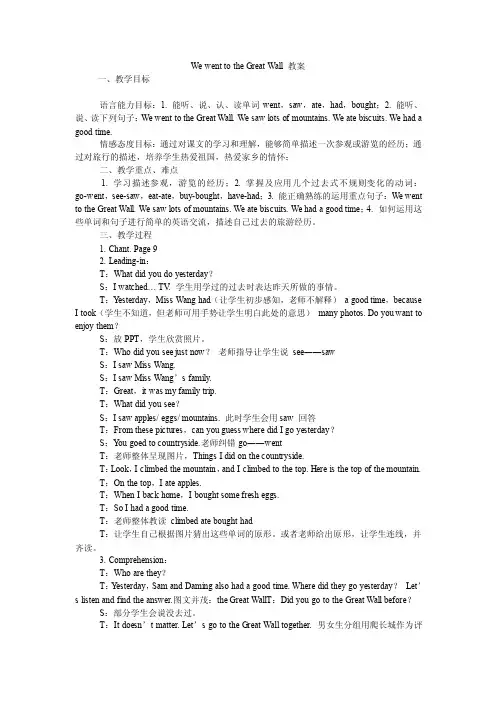
We went to the Great Wall 教案一、教学目标语言能力目标:1. 能听、说、认、读单词went,saw,ate,had,bought;2. 能听、说、读下列句子:We went to the Great Wall. We saw lots of mountains. We ate biscuits. We had a good time.情感态度目标:通过对课文的学习和理解,能够简单描述一次参观或游览的经历;通过对旅行的描述,培养学生热爱祖国,热爱家乡的情怀;二、教学重点、难点1. 学习描述参观,游览的经历;2. 掌握及应用几个过去式不规则变化的动词:go-went,see-saw,eat-ate,buy-bought,have-had;3. 能正确熟练的运用重点句子:We went to the Great Wall. We saw lots of mountains. We ate biscuits. We had a good time;4. 如何运用这些单词和句子进行简单的英语交流,描述自己过去的旅游经历。
三、教学过程1. Chant. Page 92. Leading-in:T:What did you do yesterday?S:I watched… TV. 学生用学过的过去时表达昨天所做的事情。
T:Y esterday,Miss Wang had(让学生初步感知,老师不解释)a good time,because I took(学生不知道,但老师可用手势让学生明白此处的意思)many photos. Do you want to enjoy them?S:放PPT,学生欣赏照片。
T:Who did you see just now?老师指导让学生说see――sawS:I saw Miss Wang.S:I saw Miss Wang’s family.T:Great,it was my family trip.T:What did you see?S:I saw apples/ eggs/ mountains. 此时学生会用saw 回答T:From these pictures,can you guess where did I go yesterday?S:Y ou goed to countryside.老师纠错go――wentT:老师整体呈现图片,Things I did on the countryside.T:Look,I climbed the mountain,and I climbed to the top. Here is the top of the mountain.T:On the top,I ate apples.T:When I back home,I bought some fresh eggs.T:So I had a good time.T:老师整体教读climbed ate bought hadT:让学生自己根据图片猜出这些单词的原形。
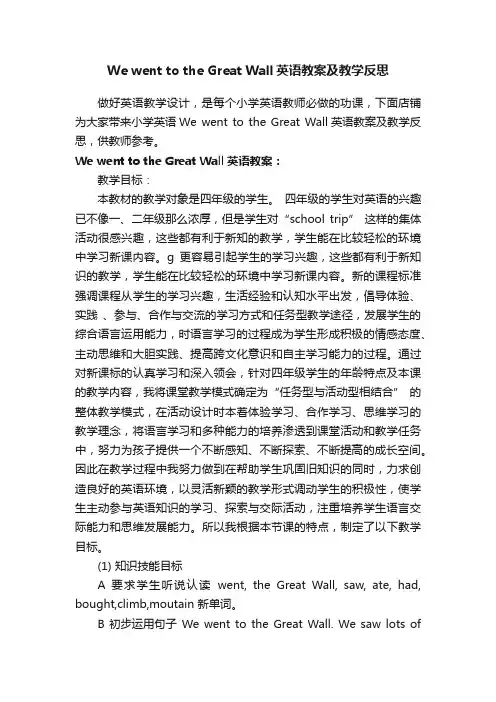
We went to the Great Wall英语教案及教学反思做好英语教学设计,是每个小学英语教师必做的功课,下面店铺为大家带来小学英语We went to the Great Wall英语教案及教学反思,供教师参考。
We went to the Great Wall英语教案:教学目标:本教材的教学对象是四年级的学生。
四年级的学生对英语的兴趣已不像一、二年级那么浓厚,但是学生对“school trip”这样的集体活动很感兴趣,这些都有利于新知的教学,学生能在比较轻松的环境中学习新课内容。
g更容易引起学生的学习兴趣,这些都有利于新知识的教学,学生能在比较轻松的环境中学习新课内容。
新的课程标准强调课程从学生的学习兴趣,生活经验和认知水平出发,倡导体验、实践、参与、合作与交流的学习方式和任务型教学途径,发展学生的综合语言运用能力,时语言学习的过程成为学生形成积极的情感态度、主动思维和大胆实践、提高跨文化意识和自主学习能力的过程。
通过对新课标的认真学习和深入领会,针对四年级学生的年龄特点及本课的教学内容,我将课堂教学模式确定为“任务型与活动型相结合”的整体教学模式,在活动设计时本着体验学习、合作学习、思维学习的教学理念,将语言学习和多种能力的培养渗透到课堂活动和教学任务中,努力为孩子提供一个不断感知、不断探索、不断提高的成长空间。
因此在教学过程中我努力做到在帮助学生巩固旧知识的同时,力求创造良好的英语环境,以灵活新颖的教学形式调动学生的积极性,使学生主动参与英语知识的学习、探索与交际活动,注重培养学生语言交际能力和思维发展能力。
所以我根据本节课的特点,制定了以下教学目标。
(1) 知识技能目标A 要求学生听说认读went, the Great Wall, saw, ate, had, bought,climb,moutain 新单词。
B 初步运用句子We went to the Great Wall. We saw lots ofmountains. We ate apples. We ha a good time.C Ss can describe the experience of visiting.(2)情感态度目标A 采用游戏教学和活动教学手段,激发学生学习英语的兴趣,提高学生的情感目标。
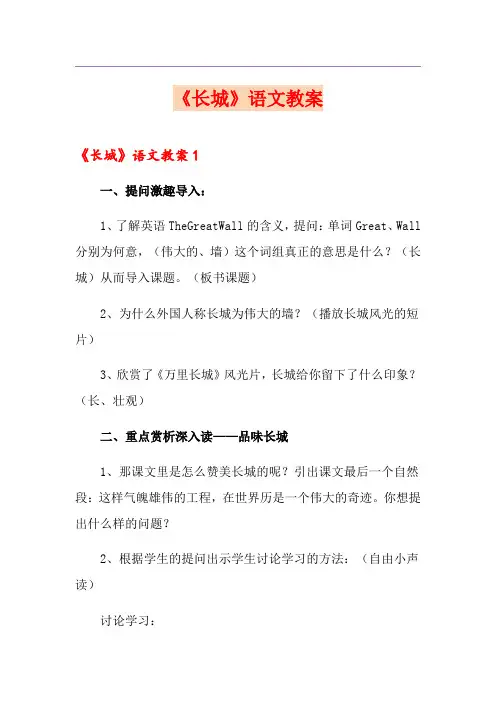
《长城》语文教案《长城》语文教案1一、提问激趣导入:1、了解英语TheGreatWall的含义,提问:单词Great、Wall 分别为何意,(伟大的、墙)这个词组真正的意思是什么?(长城)从而导入课题。
(板书课题)2、为什么外国人称长城为伟大的墙?(播放长城风光的短片)3、欣赏了《万里长城》风光片,长城给你留下了什么印象?(长、壮观)二、重点赏析深入读——品味长城1、那课文里是怎么赞美长城的呢?引出课文最后一个自然段:这样气魄雄伟的工程,在世界历是一个伟大的奇迹。
你想提出什么样的问题?2、根据学生的提问出示学生讨论学习的方法:(自由小声读)讨论学习:①、用自己喜欢的方式读课文1-2自然段,想想:为什么说长城是气魄雄伟的工程,在世界历是一个伟大的奇迹?②、划出描写长城气魄雄伟的句子,并写写自己的体会。
③、试着读出长城气魄雄伟的气势来。
(找到以后,可以同桌或前后互相交流交流。
)交流(一)(1)、同学们,有谁找到了描写长城气魄雄伟的句子?(生说“远看长城,它像一条长龙,在崇山峻岭之间蜿蜒盘旋”)板书:像一条龙作者这是从哪里看长城的?板书:远看(2)、课文是用什么方法写出长城的长呢?(比喻)体会这样写的好处,并读出有关句子。
师:作者为什么把长城比作龙而不是其他呢?(龙的形态长而弯,样子很威武)师:同学们,看课文插图,长城在崇山竣岭之间蜿蜒盘旋,多像一条长龙啊!龙是我们中华民族的象征,课文把长城比作长龙,写出了它雄伟的气势,谁来读?(指名读)3、在这一段中,作者还采用了什么方法写出了长城的长呢?(列数字)“一万三千里”(结合地图理解其长。
)是的,这个数字让我们知道了长城的具体长度,从地图上我们知道山海关在河北省和辽宁省的交汇处,而嘉峪关在甘肃省,这中间经过了11个城市,从这里我们就能感受到长城非常的——长(生说)生带着惊叹读这段话。
同学们,读完这段话,让我们闭上双眼,展开想象:长城东到山海关,西至嘉峪关,这条巨龙舞动着一万三千多里长的身躯,在蓝天下飞腾,在大地上起舞,在崇山峻岭中蜿蜒盘旋。
幼儿园祖国长城教学教案教学主题:祖国长城适用年龄:幼儿园小班教学时长:30-40分钟教学目标:1. 认识祖国长城,培养幼儿对祖国的热爱和尊重;2. 了解长城的历史和文化内涵;3. 提高幼儿的观察能力和表达能力。
教学准备:1. 祖国长城图片或模型、幼儿绘画用具、卡片、音乐播放器等。
2. 教师提前准备关于长城的历史和文化的资料。
教学过程:Step 1: 导入教师播放旅游片段,介绍长城的美丽景点。
然后问幼儿是否看过或听说过祖国长城。
Step 2: 绘画教师给每位幼儿分发绘画用具,让他们画出自己理解的祖国长城。
在幼儿绘画的时候,让老师适时地给他们一些灵感,例如你可以提供长城的图片让他们参考、或是问问他们对长城的看法和想象等等,鼓励他们自由表现。
Step 3: 认识长城教师跟幼儿们分享相关的图片、资料,并帮助幼儿辨认粗糙的石头和砖块是如何排列在一起建造出祖国长城的。
通过对幼儿的了解,并解释一些理念,可以提高孩子们的注意力和兴趣,并开展他们的好奇心。
Step 4: 了解长城历史(1) 教师让幼儿们利用卡片和绘图来展示李世民修筑长城这段历史,并带领幼儿们说说自己的看法。
(2) 之后,老师继续介绍长城的文化内涵,告诉他们这是我们国家的重要历史和文化遗产,让他们能够理解长城的巨大意义,培养幼儿对祖国的热爱和尊重。
Step 5:音乐欣赏为了加深幼儿对长城的理解,教师带领幼儿们欣赏有关长城历史的歌曲,例如《万里长城永不倒》,一面唱一面跟着歌曲的节奏摆动手臂。
Step 6:小手工制作在鼓励孩子了解长城的同时,也可以帮助他们做一个与长城有关的小手工制品,例如木制长城,帮助每个幼儿建立自己的祖国情感,进一步增强他们对国家和文化的热爱。
教学评估:评估幼儿是否掌握有关程度。
教学拓展:如果教师时间充足的话,可以带幼儿们到长城实地参观,让他们更加应用抽象的概念,进而产生更深入的了解。
翻译:Teaching Theme: The Great Wall of ChinaAge: KindergartenDuration: 30-40 minutesTeaching objectives:1. Understanding of the Great Wall of China, cultivate children's love and respect for the motherland.2. Learning about the history and cultural significance of the Great Wall of China.3. Improve children's observation and expression ability.Teaching preparation:1. Photos of the Great Wall of China or models, children's drawing tools, cards, music players, etc.2. Teachers prepare materials about the history and culture of the Great Wall of China in advance.Teaching process:Step 1: IntroductionThe teacher plays a travel clip to introduce the beautiful scenery of the Great Wall of China. Then ask the children if they have seen or heard of the Great Wall of China.Step 2: DrawingThe teacher gave each child drawing tools and asked them to draw their own understanding of the Great Wall of China. While the children are drawing, the teacher can provide them with some inspiration in a timely manner, such as providing picturesof the Great Wall of China for them to refer to, or asking them for their opinions on the Great Wall of China, etc., encouraging them to freely express themselves.Step 3: Understanding the Great Wall of ChinaThe teacher shares relevant pictures and materials with the children and helps children recognize how rough stones and bricks are placed together to build the Great Wall of China. Through understanding the children and explaining some concepts, attention and interest can be raised, and curiosity can be developed.Step 4: Understanding the history of the Great Wall(1) The teacher asks the children to use cards and drawings to show the history of Li Shimin building the Great Wall, and leads the children to discuss their opinions.(2) Then, the teacher continues to introduce the cultural significance of the Great Wall of China, telling them that this is an important historical and cultural heritage of our country and allows them to understand the huge significance of the GreatWall of China and cultivate children's love and respect for their motherland.Step 5: Music AppreciationTo deepen children's understanding of the Great Wall, the teacher leads the children to listen to historical songs about the Great Wall of China, such as "The Great Wall Forever Stands", and sway their arms to the rhythm of the song.Step 6: Small handicraftsWhile encouraging children to understand the Great Wall, they can also help them make small handicrafts related to the Great Wall, such as a wooden Great Wall, to help each child establish their own national sentiment and further enhance their love for their country and culture.Teaching evaluation:Evaluate whether the children have mastered relevant knowledge.Teaching expansion:If the teacher has sufficient time, the children can be taken to visit the Great Wall of China in person, which can help them apply abstract concepts and further deepen their understanding.。
raz m the great wall of china 教案教学目标:让学生了解中国的历史和文化,以及长城的重要性和历史意义。
帮助学生掌握基本的阅读技能,如猜测词义、理解句子等。
培养学生的跨文化意识,提高其对文化差异的敏感性和包容性。
教学内容:介绍长城的历史和文化背景。
通过图片和文字描述,展示长城的建筑风格和特点。
通过小组讨论和分享,让学生了解不同国家和文化对长城的认识和看法。
教学难点与重点:难点:帮助学生理解长城的历史和文化意义,以及其在世界文化遗产中的地位。
重点:通过阅读文章和观看图片,让学生了解长城的建筑风格和特点,以及其在中国的历史和文化中的重要性和意义。
教具和多媒体资源:投影仪和屏幕。
关于长城的图片和文章。
关于中国历史和文化的背景资料。
教学方法:激活学生的前知:通过提问和讨论,了解学生对长城和中国历史的了解程度。
教学策略:采用讲解、示范、小组讨论和案例分析相结合的方法,帮助学生掌握知识和技能。
学生活动:组织小组讨论和分享,让学生了解不同国家和文化对长城的认识和看法。
教学过程:导入:通过提问和讨论,引导学生思考长城的历史和文化意义。
讲授新课:介绍长城的历史和文化背景,展示长城的图片和文章,引导学生了解长城的建筑风格和特点。
巩固练习:组织小组讨论和分享,让学生了解不同国家和文化对长城的认识和看法。
归纳小结:总结本节课所学的知识和技能,引导学生思考长城的历史和文化意义。
评价与反馈:设计评价策略:组织小组讨论和分享,观察学生的参与程度和表现。
提供反馈:根据学生的表现,给予及时的肯定和指导,帮助他们更好地掌握知识和技能。
Unit1 The Great WallTeaching materials:Book 7 Module 1 Unit 1 The Great WallTeaching aims:1. Be able to master words: more, postcard(s), thousand, kilometer(s),million.2. Be able to understand and use:Tell me more about… It’s a pictureHow long/big is it? It’s about … It’sgot …3. Be able to understand conversations and describe different places andthings.4. Be able to love their hometown and our country.5. Be able to cooperate with each other.Key points: T o learn to describe things and different places.Difficult points: How to describe by using numbers.Teaching aids:The multi-Media , word cards , key sentence structurescards, postcards.Teaching steps:Step 1: Warming up and lead-in.1、Warming up:T: This is the first time I come to Xiamen, Xiamen is really beautiful,people are very good, so I want to make lots of friends here, do you wantto be my friend? OK , I am Sara. Please say Hello to me.(Teacher encourages students by using body language)2、Lead-in:T: Do you want to be my friends? please introduce yourself first!S: (Encourage students try to say) My name’s… I’m…T: (ask another) What’s your hobby?....T: Do you want to know more about me?My hobby is collecting postcards. Look, here is my postcards book,they are very beautiful. (Show the word ‘postcard’ and ‘postcardsStep 2: Look and say.1、Presentation :①ShowingT: Look at the screen. They are all postcards, this is a picture ofntroduce the postcards on thepanda, look at this one, it’s a picture of …(Iscreen)②New words and sentences.Are they beautiful? Now, let’s play a guessing game.T: (Take one postcard) please guess what it is about?fat and lovely. It has got a … what is It’s a kind of animal, it’sit(describe the panda)S:( Guess) It’s a…T: Yes, It’s a picture of a panda (Lead to say ‘It’s a picture of…and Tell me more about the panda, ok? (Show the word ‘more’,sentence ‘Tell me more…’ . )S: (Lead the student to say some more about panda, and then givethe postcard to him.) It is for you!T: (Take another postcard of the Changjiang River ) It is a river in China,)it is very long…(Describe the Changjiang RiverS: It’s a picture of …( Lead to answer with ‘It’s a picture of T: Tell me more about The Changjiang River. How long isit? .( Show the sentence ‘How long is it?’)Look at the screen, I have some answers here, which one is right?Show the word card ‘thousand’ and ‘kilometre’.Then lead to say and choose one answer. Check the answer.T: The last picture, it is a big city in China, it is in the north, itcold in winter… (Describe Harbin)S: It’s a picture of…T: Tell me more about Harbin. How big is it? (Show the sentence‘How big is it?’)Then lead to say and choose one Show the word card ‘million’.answer.Check the answer.2. Dialogue(Show a picture of Daming and ask:“ Who ‘s that little boy?”)T: Daming is visiting America, he is talking something with hiscousin, Simon. What are they talking about? Do you w ant to know? Let’slook the questions on the screen and listen to the dialogue, then answerthem.Are the postcards beautiful? Is the Great Wall Short?How long is the Great Wall? How big is Beijing?How big is New York?Then check the answer.Step 3: Pair-work.1、Orders:T: Tomorrow I will be free, I want to travel in Xia Men, whereshould I go? Can you help me? Do you want to be my guider and tell memore about Xiamen? Here are some beautiful postcards, please chooseone and describe it, I want to know where the most beautiful it is. OK?2、Work in pairs:Ss choose the postcards and describe in small groups.Then write something more about the postcard on the Showing card,then say it out.3、Share the results:(Ask some students in each group to be a guider, and introduce theirpostcards.)T: I think … is the most beautiful place, I want to go, and I can’t wait, let’s go now, ok? Say goodbye to other teachers.Step 4:HomeworkBlackboard writing:The Great WallIt’s a picture of … postcardTell me more … moreHow long is it? It’s about … thousand kilometresHow big is it? It’s got… million people。
教学内容:Lesson 12 A Visit to the Great Wall教学目标:1.学生能听懂和理解这个简单的故事。
2.学生可以根据故事进行问答。
3.学生可以向同学复述故事。
重点、难点:1.学生能听懂和理解这个简单的故事。
2.学生可以根据故事进行问答。
教学准备:教学光盘教学过程:一、Pre-readingGreeting:Do you know about the Great Wall?预测故事内容,培养学生思考能力。
二、While-readingStep 1:Listen to the story, order the pictures.整体感知故事,听之前布置任务,将图片排序,让学生听的更认真更有目的,同时理清故事脉络。
Step 2:Read the Story 1—3,answer the questions.个体或小组分页读故事,从细节处入手,理解故事内涵,完成练习。
不同形式的练习,检测学生对故事的理解。
2. Read the story 4—6, fill in the blanks.Let’s know more _____ things about the Great Wall.In China ,people say“He _____ does not go to the Great Wall is not a ____ man.”Don’t ____ or ____ on the Great Wall. Let’s keep it ____ and _________.练习形式既要多样,还要分层次,由易到难逐步递进。
Step 3:Post-readingWhere else do they visit? Talk about a new story“A visit to the Palace Museum”.二、Homework:Listen and read the story. Retell the st o ry to your friends.课后反思:。
The Great Wall 教案教学设计(北师大版英语高一)一.教学内容分析与要求1)语言知识与语言技能的要点及要求(1) .掌握下列短语和词汇的用法:be located in ,have sth./sb done ,be forced to do sth. ,by hand ,enough to do sth. ,be used to do sth. , be famous for , extend from ….to …,protect ,remember ,cary ,excited ,climb .(2) .掌握下列句型:a. It is said that …b. It takes /sb. Some time to do sth.(3) .掌握被动语态的基本用法:be done(4) .通过限时阅读能正确理解文章内容,能准确回答课文后的问题。
2)情感态度与价值观目标(1)培养学生自主学习意识:小组合作学习和探究学习的良好习惯。
(2)培养学生克服学习中遇到的困难及合作探究解决问题的方法和途径。
(3)通过对课文的学习,了解中国的长城是中华民族的骄傲。
增强民族自豪感,更加热爱我们的祖国。
3)重点与难点重点:(1)熟练掌握下列词汇和短语:be located in ,have sth./sb.done ,be forced to do sth. ,by hand , enough to do sth. ,be used to do sth. ,be famous for ,extend from …to…,protect ,reme mber, carry ,excited ,climb .(2)被动语态的用法。
难点:记忆和运用阅读材料中的生词和短语,正确运用被动语态结构。
4)应达到的目标(1)能正确使用课文中重点词汇和短语,并能顺利完成相关基础练习。
(2)掌握被动语态的基本构成形式和用法。
The Great Wall教案
一、教学目标
1.学会听、说句子 These postcards are great! It’s a picture of the Great Wall.
2.运用Tell me more的操练来了解讲诉某个地方(事件)的情况。
3.学习新单词: postcard, more, thousand, kilometre, million 4.学会听How long,How big开头的特殊疑问句。
5.用景点进行说话练习。
二.教学重点
1.学会听、说句子 These postcards are great! It’s a picture of the Great Wall.
2.运用Tell me more的说话操练来了解The Great Wall , New
York, Beijing 情况。
三、教学难点
1.流利说一些简单的表达It ’s very big. It’s got --- . That is big That’s a lot.
2.了解关于数词的表达about eight million people , about
six thousand seven hundred kilometre
四、教学用具:录音机单词卡片学生照片明信片
五、教学过程:
1. 热身复习:老师问候学生们,询问假期里都去了哪里?Where have you been in the summer holiday? I have been to (平潭,武夷山,长乐ect)建议他们通过展图片和照片介绍相关的情况,并要求使用It’s a picture of ----. It’s very---.老师从学生的图片中取几张比较典型的进行提问:“Do you know this place?”引导学生自由回答. T: “Do you know this place?” S:Yes, It’s ---
T: “Can you tell me something about it? S:Yes, It’s --- 2.师拿出一张名信片说“look,a beautiful postcards”板书跟读几遍。
介绍名信片(背面可以用来书写,邮寄,另一面是漂亮的图片)师出示一些名信片说“在名信片的一面printed a lot of beautiful pictures,such as, the Great Wall, The Huangshan Mountain, 师说“It’s a picture about the Great Wall. 跟读板书,学生看图片练习说It’s a picture---句子。
3.学生跟读后(长城)学生将课前准备收集好关于的资料用汉语进行讨论,当两三个学生说一部分时师:“刚才讲得很好,Tell me more(板书)两三个学生再介绍长城时师又说Tell me more这时Do you know”师英语再Do you know the Chinese meaning “Tell me more”. Yes(再告诉我一些)师解释说也可以说Tell me more about The Great Wall 板书并解释汉语意思
4.学习单词, 师拿出 hundred thousand million ,kilometers people 卡片跟读师问“Tell me more about the Great Wall. How long is it? 学生用汉语回答后,师出示It’s about 6,700米再跟读thousand seven hundred kilometers师问“Tell me something about New York. How big is it? 学生用汉语回答后,师出示It’s got 8,000,000人再跟读eight million people师问“Tell me something about Beijing . How big is it? 学生用汉语回答后,师出示It’s got 14,000,000人再跟
读 fourteen million people
5.学习常用口语That is big. That’s a lot! It’s very big.跟师朗读。
将挂图挂在黑板上,播放录音,请学生看图或动画说一说Simon 是谁Daming在哪里?两人在做什么?再听录音,要求学生勾画出文中的重要的信息?关于长城,纽约,北京他们都谈了什么?情学生模仿跟读,并注意人物所使用的语言。
把全班分成两组,一组扮演Simon一组扮演Daming,表演对话
6.师拿出一张图,学生猜一猜物品是什么?当学生无法猜一猜物品是什么时,使用Tell me more,请求获取更多的信息,T: It’s an animal. S: Tell me more T: It’s very big.
S: Tell me more. Is it long? T: It’s long.
S: Tell me more. Is it tall? T: It’s tall
S: :It’s an elephant. T: You ’re right.
等等师给学生分组,各分配说话的任务,小组共同展开这个游戏搜集一个大城市的图片并对基本情况和人口进行调查,然后请他们拿着图片向其他同学介绍。
7.家庭作业熟读课文,可以背诵。
六、教后反思:
这节课让学生学习用英语介绍中国的长城,用英语会表达长城的历史年数和它自身长度,会用数字表达about eight million
people , about six thousand seven hundred kilometers ,由此学会句型How long \ old is it?.课堂上我采取学生自读找出问题,提出问题,然后师生共同解决问题的教学方式;然后分组讨论,分角色表演,模仿重造对话等形式让学生进行新课巩固。
本节课按《小学英语新课标》的要求,结合儿童年龄特点、认知规律和心理特点处理教材、设计教材。
不足之处
是学生的主体地位还没充分凸显出来,只有充分发挥学生的主动性,才能真正做到有效教学。
六年级的学生就要进入中学学习,他们必须要具备一定的学习能力和解决问题的能力,因此现在该放手让他们自己做的事教师就一定不能代劳,这也是我们小学英语教学的重要目的之一。